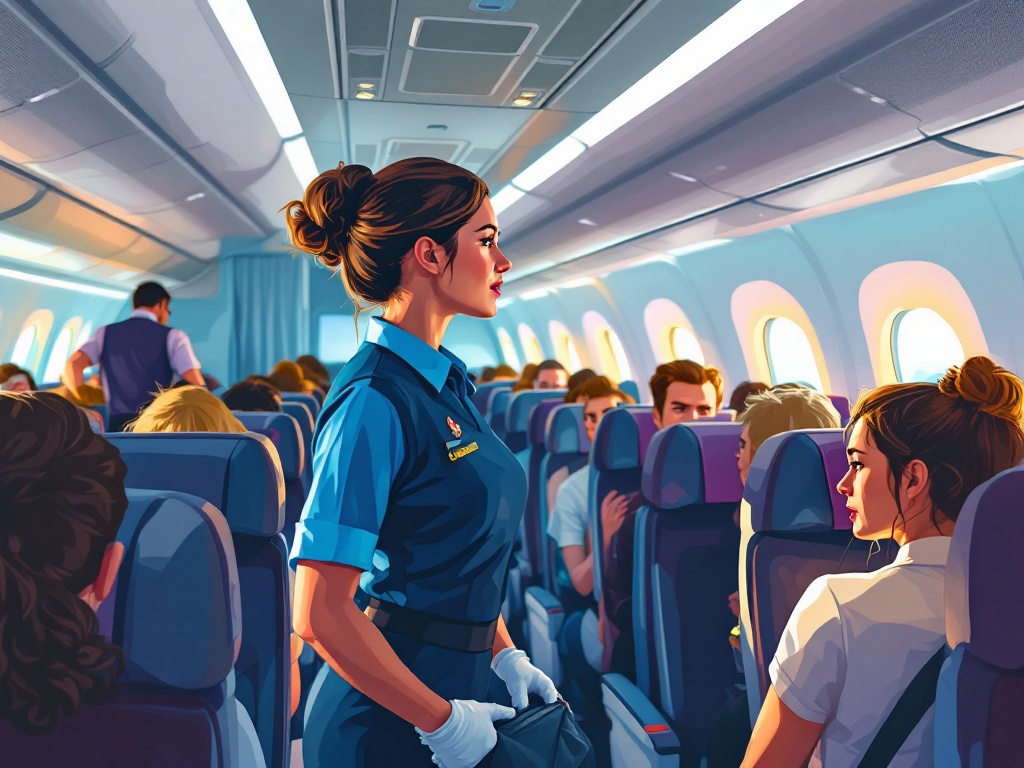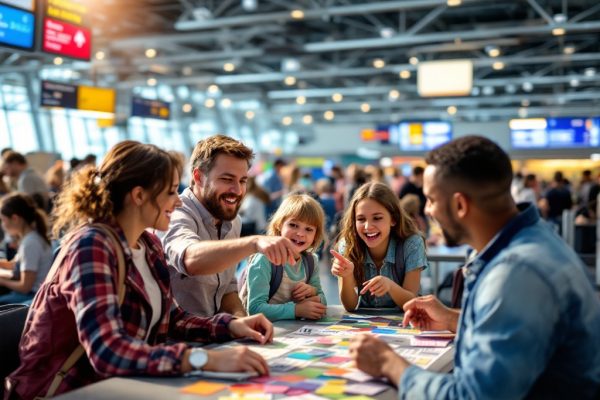How Do Flight Attendants Deal with Turbulence?
Ever wondered how flight attendants keep their cool amidst bumpy skies? Turbulence, a leading cause of in-flight injuries, requires skilled management. This article explores the rigorous training flight attendants undergo, from simulations to drills, equipping them to handle any turbulence level. Discover the crucial safety protocols they implement, from securing galleys to calming anxious passengers. Learn how their expertise ensures a safer and more comfortable flight for everyone, and discover valuable tips for managing your own turbulence anxiety. Read on to understand the vital role these professionals play in keeping you safe at 30,000 feet.
Important information

- Flight attendants undergo rigorous training, including simulations and drills, to handle various turbulence levels and passenger anxieties.
- During turbulence, cabin crew secure the cabin (galleys, loose items, overhead bins) and ensure passengers are seated with seatbelts fastened. Services are paused, especially during moderate turbulence, to prevent injuries.
- Flight attendants reassure anxious passengers by explaining turbulence as a normal part of flying, offering tips like deep breathing and distractions, and providing updates.
- Turbulence is a leading cause of injuries to flight attendants, highlighting the importance of their training and safety procedures.
- Passengers are advised to keep their seatbelts fastened, remain seated during turbulence, and communicate any concerns to the flight attendants.
The Role of Flight Attendants in Managing Turbulence
Flight attendants play a crucial role in managing turbulence and ensuring the safety and comfort of passengers. Their rigorous training prepares them to handle various levels of turbulence while maintaining a calming presence to reassure anxious flyers. They efficiently secure the cabin, instructing passengers on seatbelt use and providing updates. These calm and efficient actions prioritize the well-being of everyone on board. Their training also covers securing galleys and addressing passenger anxieties, with an emphasis on effective communication during turbulent conditions.
What Is Turbulence and Why Is It a Safety Concern?
Turbulence, those unpredictable air movements that make flights bumpy, is the leading cause of injuries for flight attendants, posing a significant safety risk. Different levels of turbulence, ranging from mild to severe, dictate varying safety procedures and passenger experiences.
How Are Flight Attendants Trained to Handle Turbulence?
Flight attendants undergo rigorous training to handle turbulence, including simulations and drills covering key procedures. This preparation equips them to secure the cabin and address passenger anxieties. By mastering safety protocols, they learn to react calmly and efficiently, prioritizing passenger safety and comfort. This extensive training enables them to effectively manage challenging in-flight situations. Here’s a step-by-step look at their training:
Initial classroom instruction covers aviation fundamentals, safety regulations, and emergency procedures.
Practical training in cabin mock-ups allows them to practice handling various in-flight scenarios, including turbulence.
Simulated turbulence exercises in motion-based simulators help them develop the skills to secure the cabin and manage passenger safety during such events.
Drills on handling medical emergencies, security threats, and evacuations equip them to address a wide range of in-flight challenges.
Ongoing recurrent training ensures their skills and knowledge remain up-to-date.
Why Must Flight Attendants Remain Seated During Turbulence?
Flight attendants must remain seated during turbulence for everyone’s safety. This measure protects them from potential injuries, allowing them to effectively assist passengers. A seated attendant also encourages passenger compliance with safety regulations.
Procedures Followed by Flight Attendants During Turbulence
Cabin crew meticulously prepare the aircraft for a smooth and safe journey. They secure galleys and manage any disruptions to onboard services. Loose items, such as meal carts and duty-free trolleys, are carefully stowed. They also confirm every passenger is seated and buckled in.
Before Turbulence
Before turbulence begins, the cabin and galley areas are thoroughly secured, including checking overhead bins. This minimizes the risk of loose objects becoming hazards, creating a safer environment for everyone onboard.
During Turbulence
When turbulence occurs, specific safety procedures are followed. Cabin crew pause services like meals and drinks. They promptly secure themselves in their jump seats as needed, carefully adhering to instructions from the pilots. Throughout, they keep passengers informed and reassured.
During moderate turbulence, services are temporarily suspended to prioritize passenger safety. Moving around the cabin at such times is risky, as hot drinks could spill and cause burns. These precautions minimize potential injuries and allow the crew to focus on essential safety measures.
How Do Flight Attendants Prepare the Cabin for Turbulence?
Flight attendants prioritize passenger safety during turbulence by securing loose items, galleys, and equipment. They also ensure that all passengers fasten their seatbelts. Turbulence is categorized into three levels: light, moderate, and severe. Light turbulence may feel similar to a bumpy car ride. Moderate turbulence can make walking difficult. Severe turbulence, while rare, is a serious safety concern. Flight attendants are extensively trained to manage all levels of turbulence and ensure passenger safety.
What Safety Protocols Are Implemented During Turbulence?
Flight attendants prioritize safety during turbulence by implementing crucial procedures. These include suspending drink and snack services, securing galleys and loose items, and instructing passengers to fasten their seatbelts. Lastly, flight attendants take their jump seats to minimize their own risk of injury.
How Do Flight Attendants Secure the Galleys and Cabin?
Flight attendants secure galley carts and equipment, stowing loose items safely. They then check the cabin to ensure passenger compliance with safety regulations, such as fastening seatbelts and storing carry-on bags securely in overhead bins or under seats.
Why Is Service Interrupted During Moderate Turbulence?
In moderate turbulence, cabin crew prioritize their own safety and securing the cabin. Loose items can become hazardous projectiles, endangering everyone onboard. Service interruptions allow the crew to address these potential hazards and focus on passenger safety.
Ensuring Passenger Safety and Comfort
Flight attendants excel at calming anxious flyers. Their composed manner and comforting words, along with clear explanations of the situation, help passengers understand that turbulence is a typical part of flying. They may suggest techniques such as deep breathing or finding a distraction. This open communication is key to alleviating fears. Moreover, flight attendants advise passengers to stay seated with their seatbelts fastened during turbulence, offering updates and assistance as required. Passengers, conversely, should always follow crew instructions and voice any concerns.
How Do Flight Attendants Calm Anxious Passengers?
Skilled flight attendants excel at calming nervous flyers. They offer reassurance, highlighting the plane’s robust safety features. While turbulence can be unsettling, they explain it’s a normal aspect of air travel and might suggest breathing exercises or distractions like engaging passengers in conversation. Regular check-ins and personalized attention further ease anxieties throughout the flight.
What Tips Do Flight Attendants Share for Turbulence Anxiety?
Concerned about turbulence? Flight attendants suggest these tips for a smoother flight. Controlled, deep breaths can help alleviate anxiety. A properly fastened seatbelt provides safety and reduces the sensation of movement. Distraction is also highly effective; listen to music or lose yourself in a good book. If you experience nausea, a cool, damp cloth or ice pack applied to the forehead or neck can provide relief. These simple steps can significantly enhance your in-flight comfort.
What Role Does Communication Play in Reassuring Passengers?
During turbulent flights, clear communication from flight attendants helps soothe passenger anxieties. They explain the aircraft’s sturdy construction and safety features, relaying updates from the pilots. This consistent reassurance effectively calms nerves. Furthermore, the crew addresses individual concerns, offering personalized support to those who need it. Flight attendants play a crucial role in maintaining calm during air turbulence. Their composed demeanor and clear explanations help passengers feel safe and informed. They explain the reasons for the turbulence and the safety measures in place. This transparency builds trust and reduces anxiety. Additionally, they provide individual attention, addressing specific concerns and offering comfort to those who are particularly anxious.
How Are Passengers Advised to Manage Their Safety?
For your safety, please keep your seatbelt fastened and listen attentively to the flight attendants. Remain seated during turbulence. If you feel any concern, please don’t hesitate to speak with a flight attendant. They are trained to provide assistance and reassurance.
















